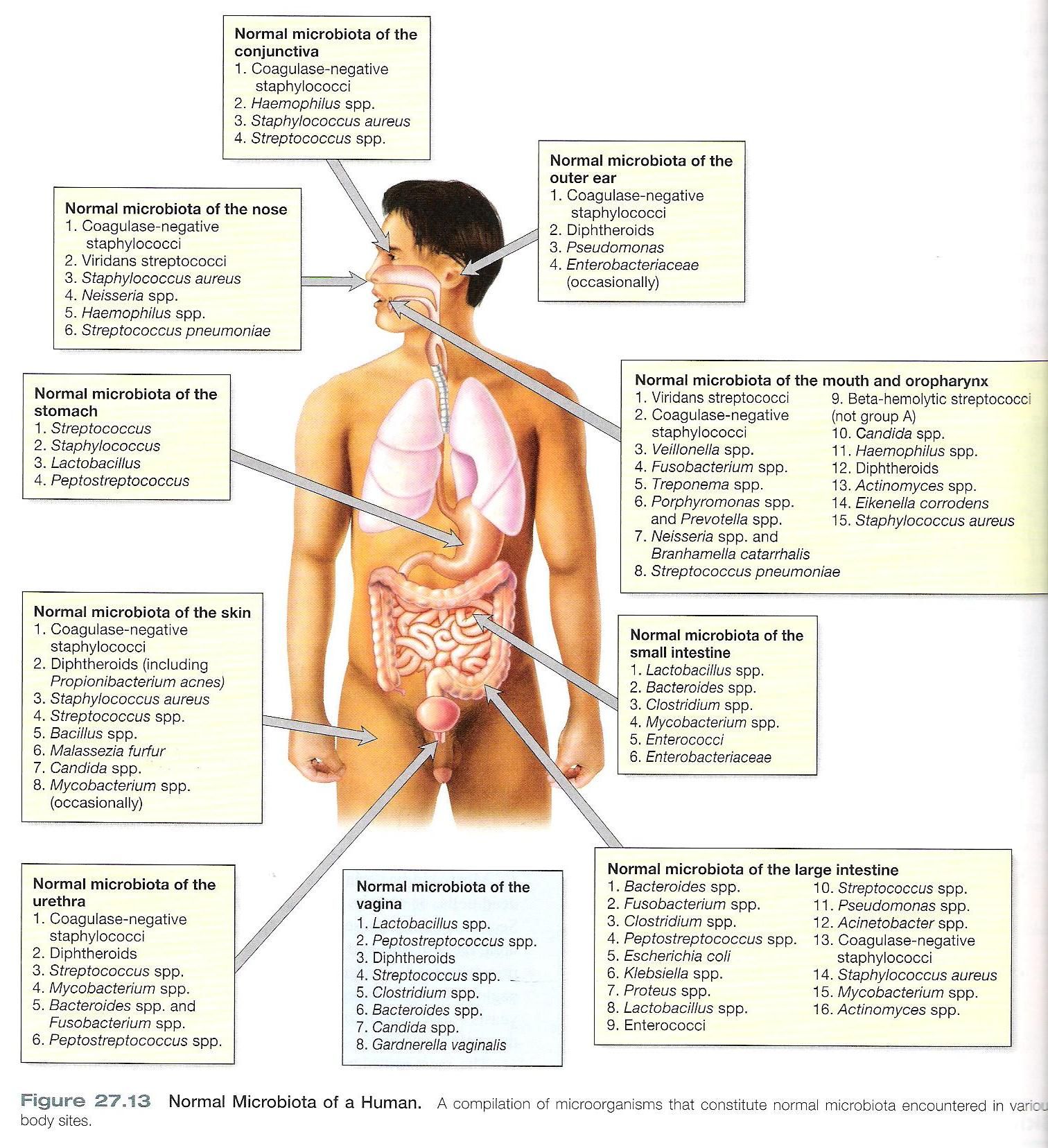Understanding microbiota
.jpeg)
Image gotten from online biology notes
You no suppose get Staph for body at all. Na Staphylococcus aureus dey cause malaria. Na Staphylococcus dey cause weakness. E dey follow cause fever. Na im dey cause make man no sabi "perform" (erectile dysfunction). E dey also cause arthritis. You wanna know the one that blew and still blows my mind anytime I hear this ad running? Na Staphylococcus dey cause nightmares!
Nightmares! Wait a minute! S. aureus causes nightmares? Damn, son!

Image gotten from Slideshare
Where I stay (Uyo, Akwa Ibom state, Nigeria), this is a very popular ad. As a matter of fact, it is one of the many ads run by many herbal medicine dealers, who claim to have the cure to anything and everything, and, in the process, heap the blame on S. aureus especially. To put this in context, S. aureus is the devil of all infections (bearing the blame for every thing that happens to man).
Think of it! Why shouldn't it? After all, coupled with man's unwillingness to read and research, we are always eager for a fall guy. Someone to take the blame and bear the brunt. Sadly, S. aureus chose to be the most popular microorganism around town. All of these could have been avoided with the simple understanding of the term "normal flora"
NORMAL FLORA/MICROBIOTA.
Without a doubt, many microorganisms survive by being in special relationships with humans no exception as we are an important ecosystem got a wide array of microorganisms. As a matter of fact, several parts of our bodies are home to different microorganisms, and when these body sites meet all physiological needs of a given microorganism, it becomes a "default" habitat for the said microorganism. This is the basis for the understanding of normal flora.

Image gotten from Google
Simply put, normal flora are microorganisms commonly associated with the human body, or parts of it. The various body sites provide differing conditions for growth, hence the difference in occurrence of these normal flora. Usually, the relationship between human host and normal flora is positive, mutual and beneficial to the health of the host (e.g degradation of complex carbohydrates like hemicellulose by exoenzymes of Bacteroidetes). Viruses and parasites are not considered members of the normal microbial flora by most investigators because they are not commensals and do not aid the host.
PARTS OF THE BODY AND ASSOCIATED NORMAL FLORA.
1. Skin.
S. epidermidis is a major inhabitant of the skin, and in some areas it makes up more than 90 percent of the resident aerobic flora. Acinetobacter sp ,Bacillus sp, Candida albicans, Corynebacterium sp, Micrococcus spp, Mycobacterium spp, Pseudomonas aeruginosa ,Sarcina spp ,Staphylococcus aureus, Staphylococcus epidermidis, Staphylococcus haemolyticus, Streptococcus viridans and Trichophyton sp can be found too, amongst others.

2. External ear.
Normal flora in this part of the body include, bit are not limited to, Corynebacterium sp, Staphylococcus aureus and Staphylococcus epidermidis.

3. Mucous membranes.
The mucous membranes are home to microorganisms such as Chlamydia trachomatis, Hemophilus influenzae, Staphylococcus aureus and Staphylococcus epidermidis, amongst others.
4. Eye.
The eyes play host to Chlamydophila pneumoniae, Haemophilus aegyptius, Haemophilus influenzae, Moraxella sp, Neisseria sp, Staphylococcus aureus, Staphylococcus epidermidis, Streptococcus viridians etc.

5. Urogenital tract.
The type of bacterial flora found in the vagina depends on the age, pH, and hormonal levels of the host. Acinetobacter sp, Bacteroides sp, Candida albicans, Corynebacterium sp, Enterobacteriaceae, Streptococcus viridans, Streptococcus anginosus and Staphylococcus aureus can be found here.

6. Oral and Respiratory Tract.
The pharynx can be a point of entry and initial colonization for Neisseria, Bordetella, Corynebacterium, and Streptococcus sp amongst others. Acinetobacter sp, Campylobacter sputorum, Haemophilus sp, Moraxella sp, Neisseria sp are a feature (predominant in the Nasopharynx). Also, Candida albicans, Haemophilus parainfluenzae, Haemophilus paraphrophilus, Peptostreptococcus sp can be found (predominant in the pharynx). Burkholderia cepacia complex, Pseudomonas aeruginosa and Chlamydophila pneumoniae can be found in the lungs.
7. Gastrointestinal Tract.
The stomach, due to its high acidity, is a relatively hostile environment for bacteria. However, many still thrive in it. Campylobacter sputorum, Campylobacter upsaliensis, Candida albicans, Capnocytophaga sp, Actinomyces viscosus, Actinomyces naeslundii, Aggregatibacter actinomycetemcomitans, Fusobacterium sp, Vibrio sputorum, Bacteroides intermedius and Bacteroides melaninogenicus, among others, can be found in the mouth. While species like Enterococcus and Enterobacter are widely distributed, Mycobacteria sp, Mycoplasma sp, Pseudomonas aeruginosa, Streptococcus viridans, Flavobacterium sp, Clostridium sp etc. can be found in the small and large intestines.

-
A chart listing normal flora around the body gotten from Google
(Detailed listings of normal microbiota can be found here and here, amongst other resources available)
WHEN NORMAL FLORA BECOME DANGEROUS.
So, technology is safe until it is in the wrong hands/place, right? Same thing with normal flora. Normal flora are usually harmless, and beneficial to the host (with emphasis on them being at their host sites), until they find their way into other parts of the body where they are not supposed to be (opportunistic microorganisms).
Opportunistic microorganisms are microorganisms that supposed to be normal microbiota, but become pathogenic (the ability to cause disease) under certain circumstances. They are just microorganisms that have left their normal habitat or environment and are found in an alien environment, a situation which could lead to disease.
Although the normal flora can inhibit pathogens, many of its members can produce disease in humans. Also, the following could lead to normal flora becoming opportunistic pathogens:
A breach in the mechanical skin barrier due to injury, a skin disease (eg, dermatitis), or an invasive medical device (e.g, central venous line).
Immune suppressant medication.
Immunocompromise due to cancer or human immunodeficiency virus infection (HIV).
Extremes of age (very young or very old).
Individual genetic factors.
BENEFITS OF THE NORMAL FLORA.
The normal flora of the human body offers many benefits. They are listed below:
There is an increased ability of the host to nourish itself since the bacteria produce vitamins that the human body is ineffective to produce on its own (enteric microorganisms produce and discharge Vitamin K and B12 whereas lactic acid microorganisms release vitamin B that are mostly utilized by the host as nutrients.).
They help digest food as they break down foodstuffs that are normally indigestible by the host into forms that are easily digestible by the hosts.
The normal microbiota assists in building ones' immune system via interferons, other cytokines, and phagocytosis. If humans gave birth to and brought up their young in a germ free environment, susceptibility to diseases via the presence of microorganisms in the environment is heightened. Thus, the normal flora helps in protecting the human body from highly pathogenic organisms.
The normal flora protects the host against infection by pathogenic organisms by:
competing with invaders for available space and nutrients, thus preventing them from reproducing.
producing compounds (e.g inhibitory fatty acids, peroxides, bacteriocins) as a by-product of their metabolic activities which kill other bacteria.
lowering the pH so that the growth of other microorganisms is hindered.
DISADVANTAGE.
If the normal flora escape from their normal location, they can cause disease. For example, E. coli which is indigenous to the intestine, can cause urinary tract infections if introduced into the bladder and S. aureus which is found in the upper respiratory tract but is pathogenic if it enters a wound or cut.
CONCLUSION.
While we actively pursue a disease-free living, we should not be in a rush to believe all we hear. The very microorganisms blamed for various diseases also have usefulness in/on our bodies! The mutual relationship between and positive benefits from the interaction of normal flora is essential in keeping balance in the body.

Image gotten from Google
- All images, unless stated otherwise, were gotten from prezi.com
- https://www.ncbi.nlm.nih.gov/books/NBK7617/
- https://en.m.wikipedia.org/wiki/List_of_human_microbiota
- https://www.ukessays.com/essays/biology/normal-flora-and-their-benefits.php
- https://www.colorado.edu/Outreach/BSI/k12activities/interactive/actidhpnf.html
- https://www.dermnetnz.org/topics/microorganisms-found-on-the-skin/
Resteemed your article. This article was resteemed because you are part of the New Steemians project. You can learn more about it here: https://steemit.com/introduceyourself/@gaman/new-steemians-project-launch